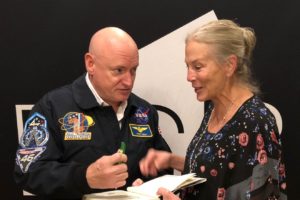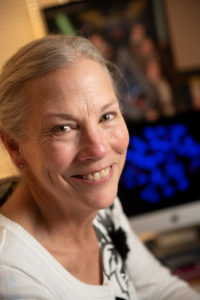By Susan Bailey
My journey started in 1969, as I – and the whole world – stood still and watched Neil Armstrong walk on the moon. Fast forward 50 years, and Christina Koch and Scott Kelly spend nearly a year in space on board the International Space Station. These out-of-this-world events bring my own, very earthly path into perspective.

Although I was born and raised in Los Alamos, New Mexico – birthplace of the atomic bomb – I never even imagined a career involving radiation. I earned a B.S. in biology from CSU in 1976 and, quite by chance, landed a job in Dr. Joel Bedford’s lab shortly thereafter. Dr. Bedford introduced me to the world of radiation cytogenetics and set the course for my career. There were definitely detours along the way, as I left the field to start a family, returned to New Mexico, and spent a decade as a full-time mom raising three kids and selling Tupperware to help make ends meet.
In 1988, another student of Dr. Bedford’s sought my help in setting up his lab at Los Alamos National Laboratory. I debated about whether or not it was the right time to go back to work, but my youngest child had just started school, so I gave it a go. Science is not a 9-5 job, which makes it a great job for a working mom. Cells grow and microscopes work around the clock, and thanks to a very understanding mentor, I could manage my work around our crazy schedule of swim meets and sick days and this, that, and the other thing. (There’s always another thing.)
The stars continued to align. In a lab just upstairs, Dr. Julie Meyne was the first to identify the sequence of the human telomere as part of the Human Genome Project. Julie inspired my own fascination with telomeres, the physical cap of chromosomes that shorten as we age.

It wasn’t long before I also had the remarkable opportunity to continue my education, thanks to a long-distance program offered by the University of New Mexico School of Medicine. My goal was to finish my Ph.D. before my youngest graduated from high school, but he beat me by six months!
In 2001, I returned to CSU – to the same department where I started – this time as a colleague of my lifelong mentor, Dr. Bedford, and started a lab of my own. With funding from NASA and the NIH, we investigated the interplay between ionizing radiation exposure, DNA repair, and telomeres. These studies ultimately led to our participation in the NASA Twins Study and our recent selection for NASA’s integrated One-Year Mission Project.
Now, as I look ahead and contemplate what the future holds for human exploration of space, I am humbled to have played a small part and excited by the tremendous possibilities as we make our way to the moon, Mars, and beyond. Certainly more and more women will experience long-duration space flight and even life on other planets, realities we need to consider now as we plan our research.
I am also inspired by the amazing opportunities our young men and women of today, including my own grandchildren, will have along the way to play their part, to dream big dreams, and to reach for the stars!